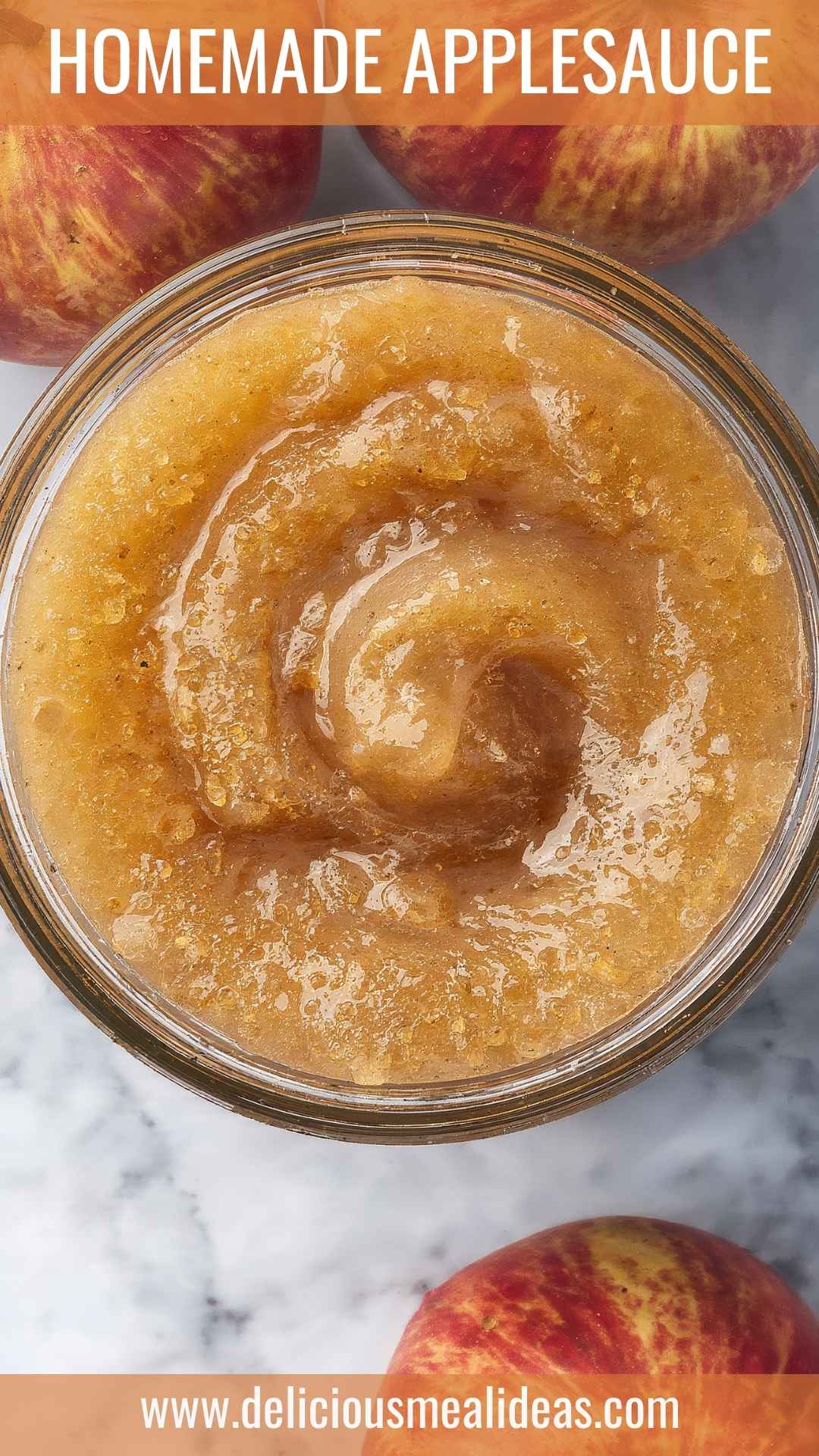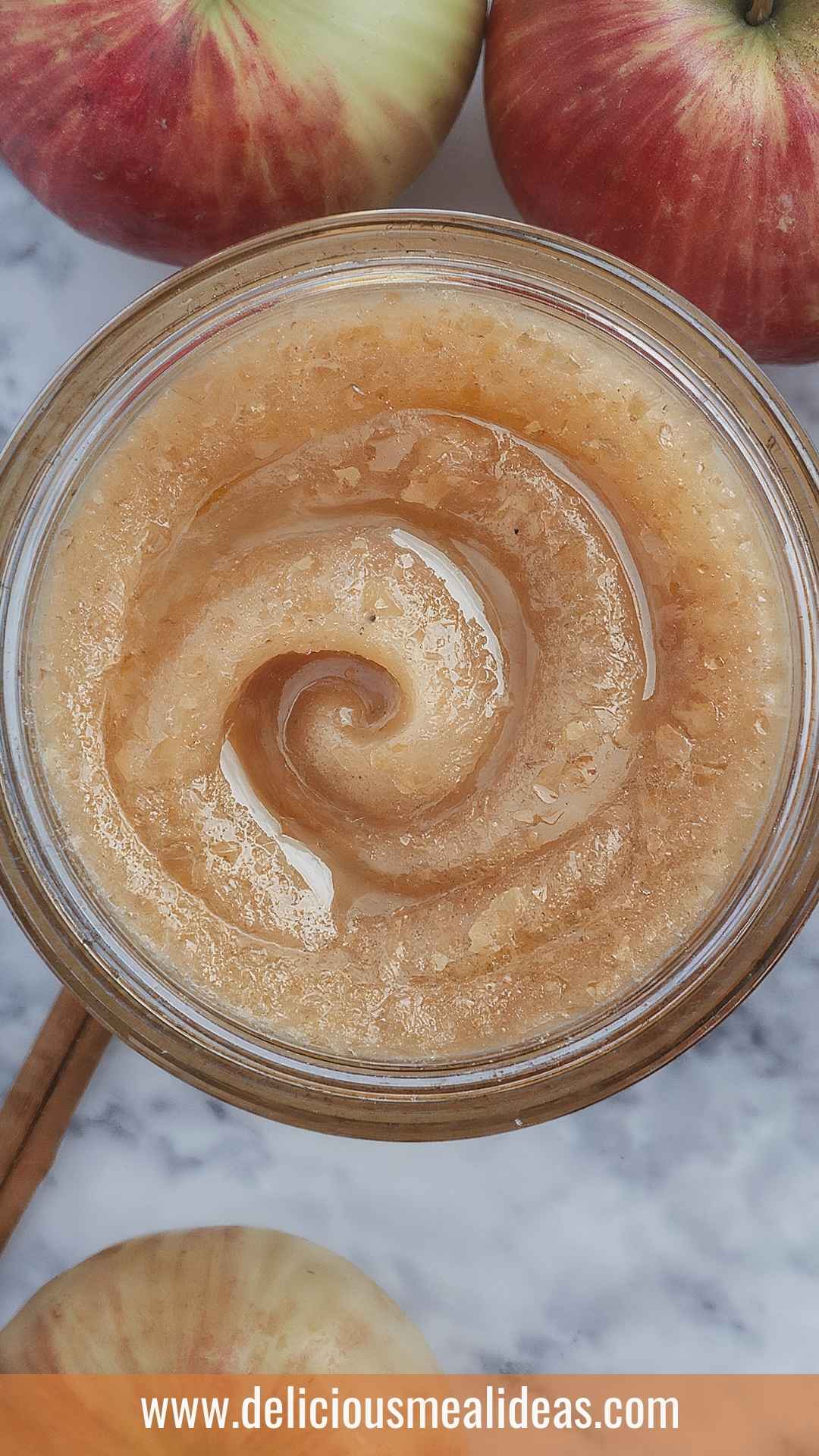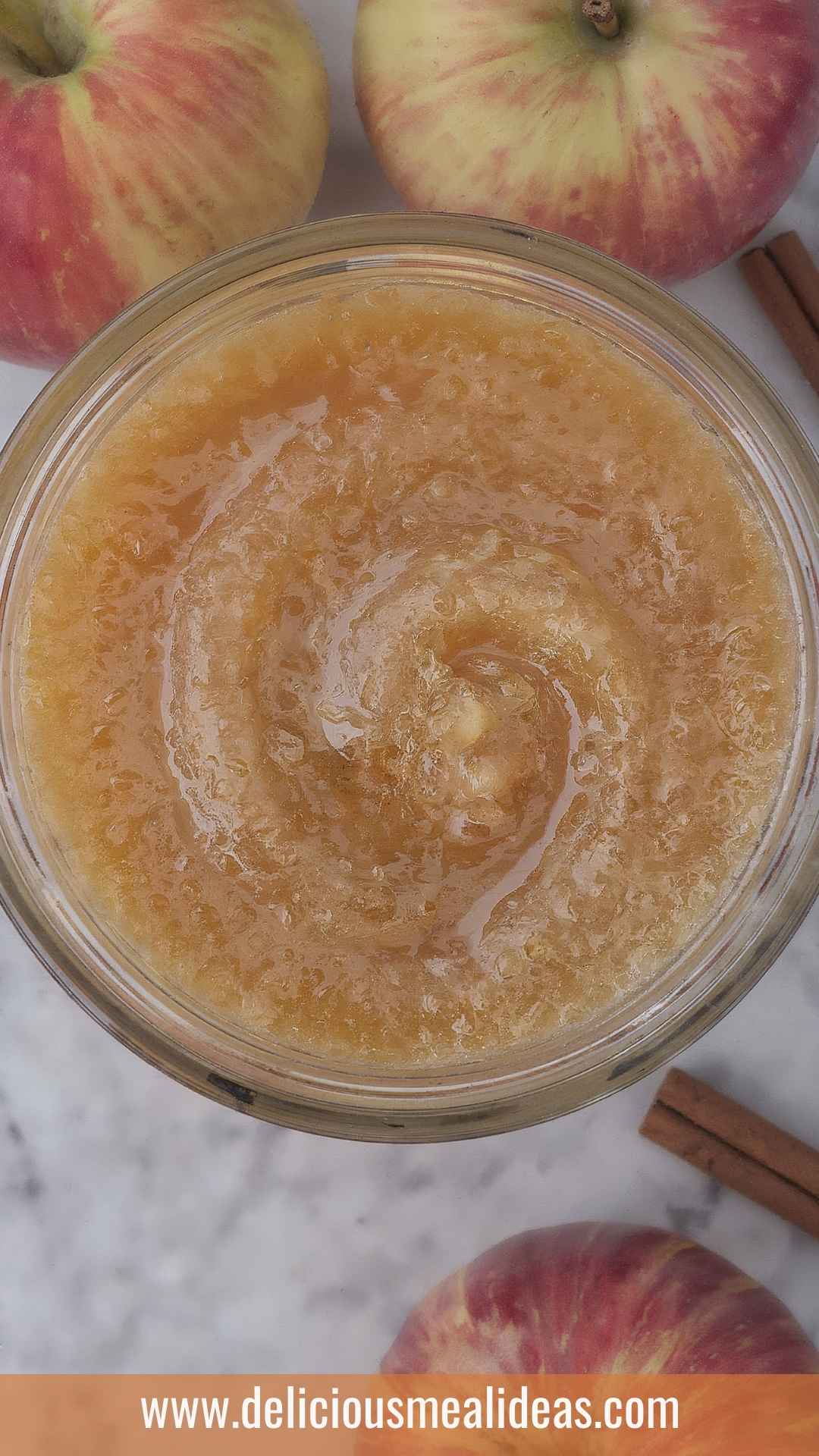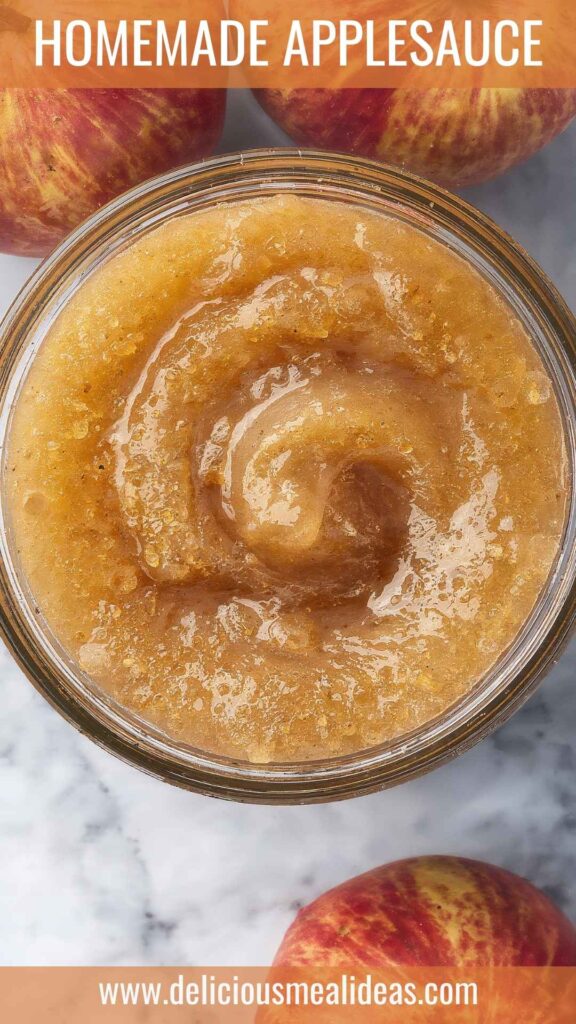Let me set the scene. You’ve just finished a hearty meal of roasted pork tenderloin, and you’re searching for that perfect side to round it all off. A warm slice of homemade applesauce dances in your mind, bringing the meal together like a culinary hug. The slight sweetness and smooth texture of applesauce can elevate your plate, offering a comforting contrast to savory dishes.
As someone who’s whipped up countless batches of this simple yet delightful treat, I can assure you that homemade applesauce isn’t just a side—it’s a staple in my kitchen. With a few easy steps and fresh ingredients, you can create a batch that will compete with your favorite store-bought version every time.

What is Homemade Applesauce?
Homemade applesauce is precisely what it sounds like—a sauce made from fresh apples. The beauty of making it at home lies in the ability to customize flavors, sweetness, and consistency to suit your taste.
You can transform a box of apples into a vibrant, flavorful puree that can be enjoyed warm or cold. Plus, there’s something undeniably satisfying about creating this from scratch. It’s more than just a recipe; it’s a way to connect with the seasons, to honor the harvest, and to bring a slice of nostalgia into your kitchen.
The Ingredients
Let’s get down to business. Here’s what you’ll need to whip up your batch of homemade applesauce:
- 4 pounds of firm, naturally sweet apples (about 8 large)
- 2 tablespoons freshly squeezed lemon juice (or orange juice for a twist)
- 1/4 teaspoon ground nutmeg (for warmth)
- 1 ½ teaspoons pure vanilla extract (it’s a game-changer)
- 1 whole stick of cinnamon or 1/2 teaspoon ground cinnamon (for cozy flavor)
- 1/8 teaspoon ground ginger (for a gentle kick)
- 1 to 2 whole star anise pods (optional, adds a subtle sophistication)
- Brown sugar, honey, or maple syrup (to taste, optional)
I’ve often experimented with various apples, and each type brings its personality. Sweet apples like Fuji or Gala yield a delightful sauce with minimal added sugar, while tart ones like Granny Smith can provide a nice zing.

How to Make Homemade Applesauce?
The beauty of making applesauce lies in its simplicity. In a nutshell, you will peel, core, and cook your apples until tender before mashing them into your desired consistency. It’s a process that is approachable for anyone. But let’s dive deeper with step-by-step directions!
Step 1: Prepare Your Apples
Begin by washing your apples under cold water to remove any dirt or wax. Pat them dry.
Next, peel each apple. I like using a good peeler; it saves time and minimizes waste. After peeling, cut the apples into quarters to make coring and slicing easier. Remove the core, leaving behind the juicy flesh, and cut the quarters into smaller chunks. This not only makes for easier cooking, but it also speeds up the process.
Step 2: Cook the Apples
Place the chopped apples in a large pot. Add lemon juice, which will brighten the flavor and help prevent browning. Then, sprinkle in your chosen spices. If you’re using cinnamon sticks, toss them into the pot now.
Add enough water to barely cover the apples. Cover the pot and cook over medium heat until the apples are tender, stirring occasionally. This should take about 20 to 30 minutes. If you’re in a hurry, you can crank up the heat a bit, but keep an eye on it. Nobody wants burnt apples!
Step 3: Mash the Apples
Once the apples are nice and soft, it’s time to mash. You have options! You can use a potato masher for a chunkier sauce, or an immersion blender for a smoother puree. Just be cautious with the immersion blender—hot splashes will happen. Work in batches if necessary.
Step 4: Sweeten and Flavor
Taste your applesauce. If you want it sweeter, add your choice of sweetener gradually. This is where you can feel like a chef! A little brown sugar, honey, or maple syrup can go a long way.
Now, mix in the vanilla extract. Let your taste buds be the guide. If you’re feeling adventurous, toss in the ground ginger and adjust the spices to your preference.
Step 5: Cool and Store
Allow the applesauce to cool to room temperature. Then, transfer it into airtight containers. Homemade applesauce can be refrigerated for up to two weeks. If you’re freezing it, make sure to leave space at the top of your container as it expands.
Notes
- If you want a smoother texture, strain your sauce through a fine-mesh sieve.
- Try using a mix of sweet and tart apples for added complexity in flavor.
- If you prefer a thicker consistency, cook the apples longer with the lid off to let some moisture evaporate.
- Experiment! Add other spices like allspice or cloves.
- If you like a more pronounced flavor, let the applesauce sit overnight. It only gets better with time!
Storage Tips
To keep your homemade applesauce at its best:
- Store it in airtight containers, preferably glass.
- Freeze it in small portions to make defrosting easy.
- Label with the date—you don’t want to forget about that delicious batch.
- If you notice any discoloration, it’s typically harmless. Just give it a stir before using.
Nutrition Information
While I’m not a certified nutritionist, I can offer some insights on what makes applesauce a wholesome choice. It’s low in calories, rich in vitamins (especially vitamin C), and a good source of dietary fiber. The absence of preservatives also makes it a healthier alternative compared to many store-bought options.
Estimated per 1/2 cup serving:
- Calories: 100
- Total Fat: 0.2g
- Carbohydrates: 27g
- Dietary Fiber: 3g
- Sugars: 12g
- Protein: 0.5g
Serving Suggestions
If you find delightful ways to use your homemade applesauce, you’re in for a treat! Here are five suggestions:
- With Pork Dishes: Homemade applesauce pairs perfectly with roasted pork. The sweetness complements the savory flavors, creating a balanced dish.
- On Pancakes or Waffles: Try dolloping applesauce on pancakes or waffles instead of syrup for a lighter breakfast option. It’s a fun twist that adds natural sweetness.
- In Baking: When baking goods like muffins or cakes, use applesauce as a substitute for oil. It helps reduce calories while adding moisture.
- With Oatmeal: Stir fresh or warmed applesauce into your morning oatmeal. Not only does it add flavor, but it also increases the nutritional value with added fiber.
- As a Snack: For a healthy snack, enjoy applesauce with a sprinkle of cinnamon or a handful of nuts. It’s a tasty way to curb cravings!
What Other Substitutes Can I Use in Homemade Applesauce?
If you’re looking for alternatives or someone in the family doesn’t like specific elements, consider these substitutes for certain ingredients:
- Lemon Juice: Apple cider vinegar can replace lemon juice. It still brightens the flavor while offering a hint of tang.
- Sweeteners: Instead of brown sugar, use agave syrup for a vegan-friendly option. It’s another way to keep it sweet without granulated sugars.
- Spices: Instead of cinnamon, try pumpkin pie spice for a fall-inspired twist. It adds warmth and fragrance effortlessly.
- Fresh Apples: In a pinch, use store-bought unsweetened applesauce, but beware of altered flavors.
- Vanilla Extract: If you don’t have vanilla, maple extract works surprisingly well. It gives an earthy sweetness similar to vanilla.

Conclusion
Making homemade applesauce is not just about putting together a few ingredients; it’s about creating a homemade treasure that can be enjoyed all year round. You’ll find its utility stretches far beyond just a side dish; it adds depth to baked goods and transforms breakfasts into something special. With just a bit of effort, you can produce a healthier, tastier alternative to store-bought applesauce.
So, gather those apples, grab your favorite cutting board, and unleash your inner chef. You’ll be delighted by the comfort and taste that comes from your very own batch of homemade applesauce. There’s something incredibly fulfilling about transforming a simple fruit into a delightful creation. Trust me; it’s worth every second!
You’ll also like the following recipes!

Homemade Applesauce – Delicious Meal Ideas
Description
Let me set the scene. You’ve just finished a hearty meal of roasted pork tenderloin, and you’re searching for that perfect side to round it all off. A warm slice of homemade applesauce dances in your mind, bringing the meal together like a culinary hug. The slight sweetness and smooth texture of applesauce can elevate your plate, offering a comforting contrast to savory dishes.
Ingredients
Instructions
Step 1: Prepare Your Apples
-
Begin by washing your apples under cold water to remove any dirt or wax. Pat them dry.
Next, peel each apple. I like using a good peeler; it saves time and minimizes waste. After peeling, cut the apples into quarters to make coring and slicing easier. Remove the core, leaving behind the juicy flesh, and cut the quarters into smaller chunks. This not only makes for easier cooking, but it also speeds up the process.
Step 2: Cook the Apples
-
Place the chopped apples in a large pot. Add lemon juice, which will brighten the flavor and help prevent browning. Then, sprinkle in your chosen spices. If you're using cinnamon sticks, toss them into the pot now.
Add enough water to barely cover the apples. Cover the pot and cook over medium heat until the apples are tender, stirring occasionally. This should take about 20 to 30 minutes. If you’re in a hurry, you can crank up the heat a bit, but keep an eye on it. Nobody wants burnt apples!
Step 3: Mash the Apples
-
Once the apples are nice and soft, it’s time to mash. You have options! You can use a potato masher for a chunkier sauce, or an immersion blender for a smoother puree. Just be cautious with the immersion blender—hot splashes will happen. Work in batches if necessary.
Step 4: Sweeten and Flavor
-
Taste your applesauce. If you want it sweeter, add your choice of sweetener gradually. This is where you can feel like a chef! A little brown sugar, honey, or maple syrup can go a long way.
Now, mix in the vanilla extract. Let your taste buds be the guide. If you're feeling adventurous, toss in the ground ginger and adjust the spices to your preference.
Step 5: Cool and Store
-
Allow the applesauce to cool to room temperature. Then, transfer it into airtight containers. Homemade applesauce can be refrigerated for up to two weeks. If you’re freezing it, make sure to leave space at the top of your container as it expands.
Nutrition Facts
Servings 4
- Amount Per Serving
- Calories 100kcal
- % Daily Value *
- Total Fat 0.2g1%
- Total Carbohydrate 27g9%
- Dietary Fiber 3g12%
- Sugars 12g
- Protein 0.5g1%
* Percent Daily Values are based on a 2,000 calorie diet. Your daily value may be higher or lower depending on your calorie needs.
Note
- If you want a smoother texture, strain your sauce through a fine-mesh sieve.
- Try using a mix of sweet and tart apples for added complexity in flavor.
- If you prefer a thicker consistency, cook the apples longer with the lid off to let some moisture evaporate.
- Experiment! Add other spices like allspice or cloves.
- If you like a more pronounced flavor, let the applesauce sit overnight. It only gets better with time!





